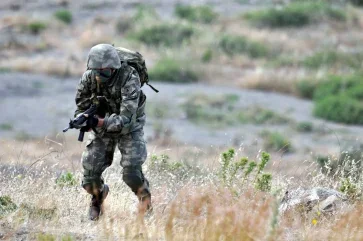
Battlefield technology and electronics place a strong emphasis on lightweight, feature-rich portable systems. They are also becoming interconnected to one another to enhance multiple functions as they relate to each other. The modern warfighter may carry radios, computers, micro-sensors, speakers and surveillance systems as well as illumination devices. All take power and share in signal processing management of some kind. They also can include GPS devices, night-vision aids and full-out Wi-Fi hotspots capable of transmitting real-time battlefield intel that, these days, exceed 5GB per second. Within all of these electronics, one common characteristic remains – all require rugged electrical cables and connectors capable of transmitting uninterrupted field data and power transmission in some of the harshest environments on the planet.
Cables and connectors can no longer be heavy, bulky and stiff. Personal wear and high portability in the new high-speed digital world has changed the demand on interconnections as much as it has on the modules used. New designs of unconventional cable design and connector formats are becoming ‘application specific’ in nature. Unmanned vehicles, soldier-worn electronics and portable electronic support vehicles with miniaturised Ethernet processing systems all require size and weight reduction while including power and increasing performance. For example, size, weight and power (SWaP) have become a keystone for designing, battlefield cable and connector systems.
Yesterday’s connectors are less of an option to meet the demands in the highly aggressive critical mission battlefield today. Oftentimes, MIL-DTL-24308 and 38999 are simply too big and heavy, as they were designed for older, larger bulkhead-type panel-mounted systems used more on aerospace technology than on foot on the battlefield. For example, the Italian Soldata Futoro – Future Soldier Programme – raised soldier-worn technology to the next level. Starting with the uniform itself, the material was designed specifically for temperate and desert environments in which many of today’s battels are being fought. Woven within the material are small ruggedised Nano Subminiature D connectors that match MIL-DTL-32139. These connectors pass data and power simultaneously underneath the body armour and are protected from stab and blast damage. Helmets were also redesigned to feature two visors – splinter and bullet proof – as well as helmet-mounted displays (HMD) that present information from a low-level TV camera mounted on the back of the helmet. This unit is also night vision capable.
Change in design
Powering and supplying signals simultaneously in one miniaturised cable has been key to the increased mobility and safety of the battlefield troops involved. Cable with both power and high-speed digital signal processing requires new and additional wire system design and jacketing. To assure strength and environmental resistance while maintaining flexibility and a small-diameter, cable materials have also changed. Additionally, EMI shielding and ensuring cyber isolation requires improved shielding methods, often using multiple shield and drain wire methods. Conventional HDMI cable used shielded twisted pair for everyday household use, but now must be smaller diameter wire with multiple strand elements and include separately shield-wrapped pairs with assigned drains per pair. New specifications are being written to accommodate these designs and help achieve very high-speed digital signal quality for the applications. Nano-miniature connectors are wired differently as well. Protecting the impedance coupling from set to set implies new wiring layouts within the connectors. Power sections are also isolated as part of the connector design and match up with the cable. Finally, polyurethane over-moulding the connector to the cable jackets assures IP-68 moisture protection and strain relief on the cable-to-connector interface. Deep inside the connector, the pins and sockets are designed to full military specifications and plated to assure over 2,000 mates and de-mates. This provides long-term reliability of the new power and signal cable throughout the battlefield duration.
As we power up our modern battlefield electronic technologies, we see the evolution of miniaturised modules from sensors, cameras, communicators and actuators. Circuit chips now run on lower voltage and current levels while the data is routed shorter distances. This trend embraces the use of smaller, lighter electronics all around and allows highly portable power systems to be integrated into one common cable routing system and lower-current carrying connectors. We are also seeing new connector securing systems that reduce use of tools to mate and de-mate connectors. New latching Micro-Ds and Nano-Ds now withstand any and all of the rugged shock and pull tests of the older fashioned jackscrew locking connectors. These changes allow for faster changeover and eliminates the use of carrying hand tools in the battlefield. Thanks to miniaturisation, mobilised ground troops today can carry much of the highest technologies, process and distribute data among their mission team more easily and without fear of power loss or of interruption.
If you want to know more about Shielding and Cyber protection on Miniature Cable and Connector Systems, download this white paper.



